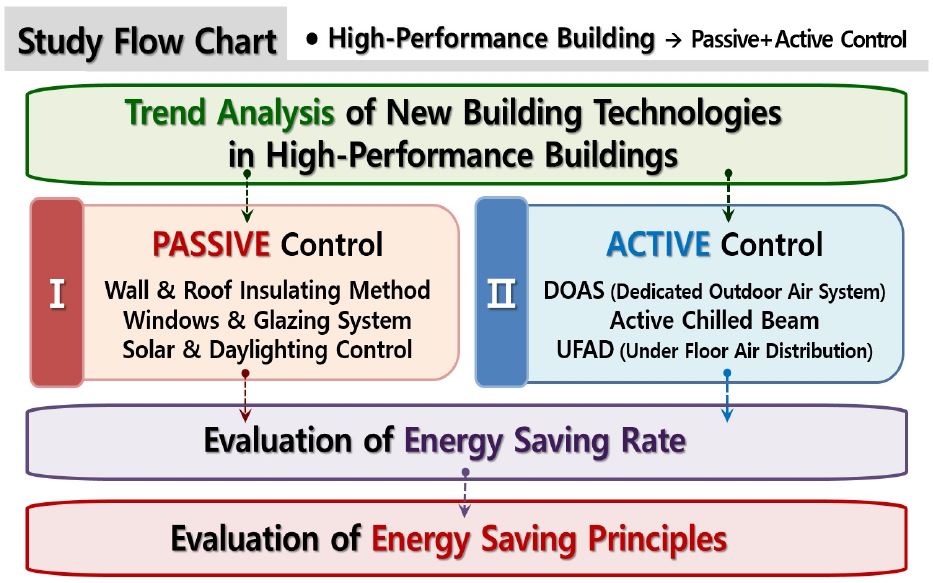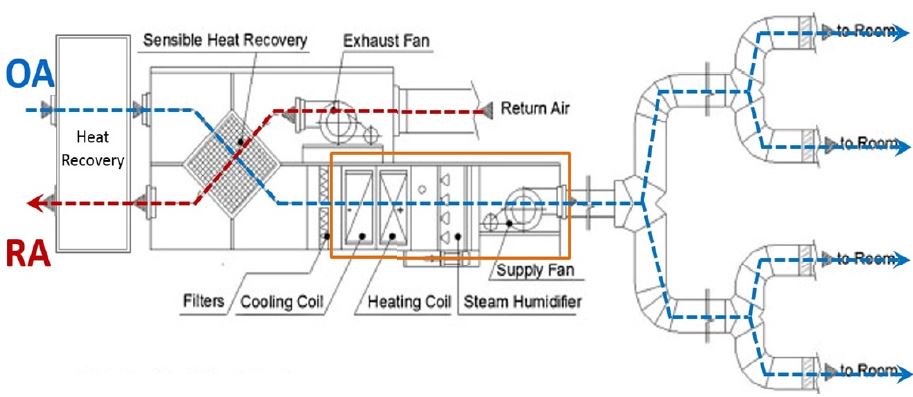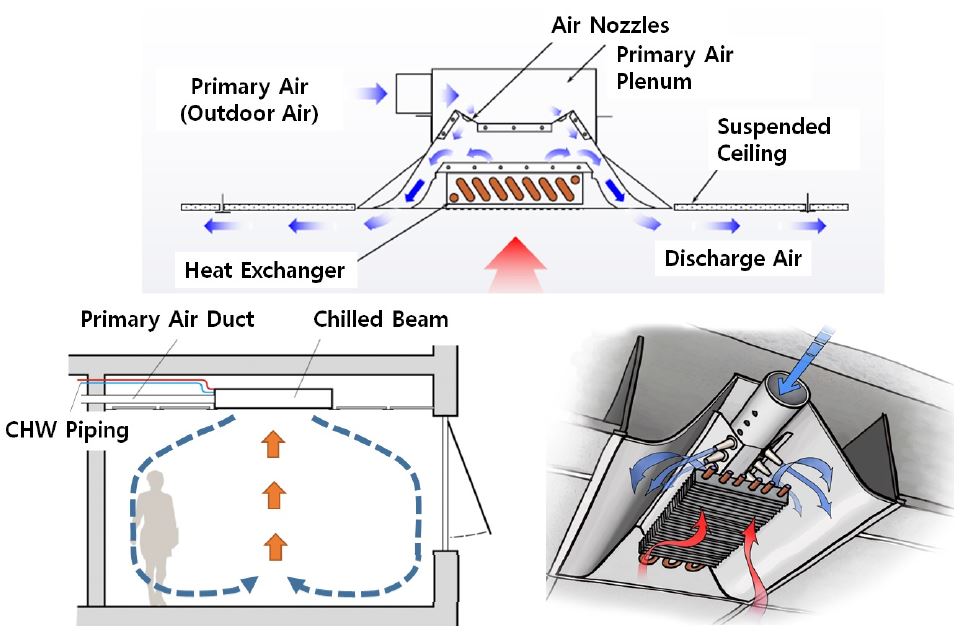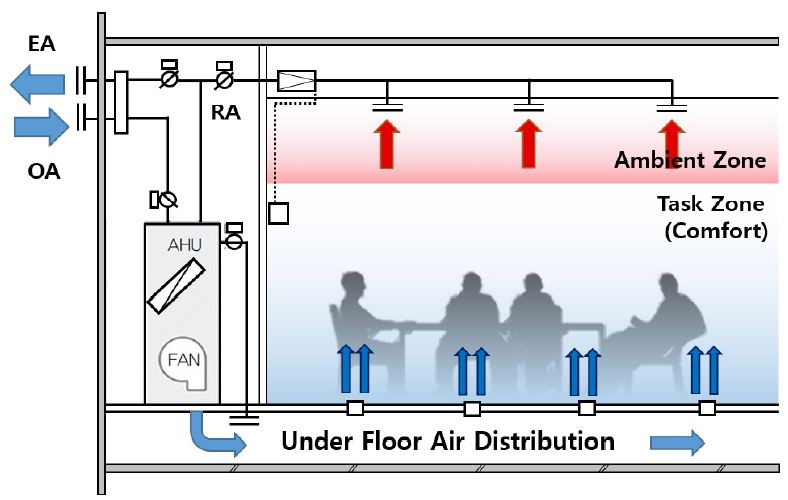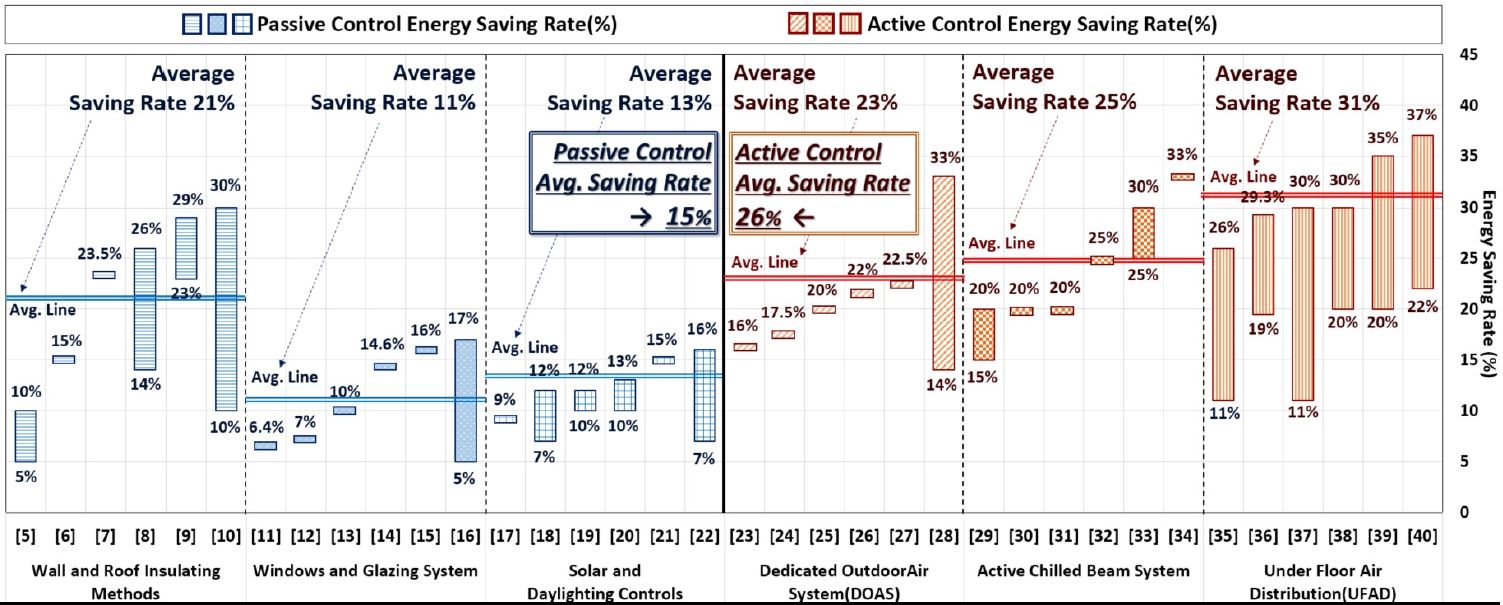
High-Performance Buildings 구현을 위한 신기술 연구 동향 및 에너지 절감 효과 평가
© Copyright Korea Institute of Ecological Architecture and Environment
Abstract
The purpose of this study is to analyze the energy performance by applying new technologies for passive and active control.
We selected new technologies for passive and active control which are based on formal study by analyzing technology applied to the High-Performance Buildings in various countries. Also, we analyzed energy saving potential for each technologies by breakdown the result of the energy saving rates in detail.
For the wall and roof insulating methods, preceding studies showed that up to 21% energy could be saved by improving roof insulation and applying proper outside insulation compared to non-insulation. For the windows and glazing system, preceding studies showed that Low-E glazing system could save up to 11% energy compared to single glazing system. Studies about solar and daylighting controls revealed that effective daylighting dimming control could save 13% of energy compared to uncontrolled situation. Studies on DOAS (Dedicated Outdoor Air System) showed that about 23% energy could be saved compared to standard VAV system. Studies on the active chilled beam showed that about 25% energy could be saved compared to standard VAV system and studies of applying UFAD (Under Floor Air Distribution) could consume 31% less energy than applying overhead system.
Keywords:
High-Performance Building, New Technology, DOAS, Active Chilled Beam, UFAD, Energy Saving Rate키워드:
고성능 건축물, 신기술, 외기전담 공조시스템, 액티브 칠드빔, 바닥공조시스템, 에너지 절감률1. 서론
1.1. 연구의 배경 및 목적
지구온난화와 고유가로 인해 전 세계적인 건축물의 화두는 탄소중립과 저에너지 건축분야로 관심이 집중되고 있다. 건축물에서 소비되는 에너지는 한 국가에서 소비되는 에너지 총량의 약 25~40%를 차지하여 국가 경제와 지구온난화에 큰 영향을 미친다. 특히, 최근 건물 수의 증가 및 생활수준의 향상과 더불어 쾌적에 대한 요구가 높아짐에 따라 냉난방에 대한 수요가 급증하고 있으며 이에 따른 지속적인 건물 에너지 소비 증가가 예상되는 상황이다.
이에 따라 우리나라는 ‘저탄소 녹색성장’을 선언하고 건물에너지 효율화 정책을 수립하기 위한 노력을 지속적으로 하고 있다. 실례로 건물에서 사용되는 에너지를 줄이기 위해 ‘건물에너지 효율등급’과 ‘건축물 에너지 절약 설계 기준’ 등 여러 가지 로드맵을 제시하고 있는 상황이다.
즉, 궁극적인 목표는 건물 에너지 성능 향상을 통한 에너지 관련 문제의 실제적인 해결책 마련이라 할 수 있다. 이를 위해 여러 제도적 장치를 기반으로 한 High-Performance Building의 구현과 에너지 절약적 신기술의 검토 및 적용이 무엇보다 중요한 상황이다. 미국 NIBS(National Institute of building Sciences)의 The Energy Policy Act of 2005[41]에서는 ‘고성능 요소기술, 에너지 효율성, Durability, Life-cycle, 쾌적과 관련된 재실자의 생산성 등을 통합, 최적화하는 건물’을 High-Performance Building이라 정의하고 있다. 현재 미국이나 유럽 등의 국외에서는 건물에너지 효율화를 위한 고성능 요소기술의 개발이 급속도로 이루어지고 있으며 그 양도 지속적으로 증가하고 있는 상황이다. 국내에서도 녹색건축기술 적용을 통한 녹색건축물을 구현하는 시도가 이루어지고 있지만 급격하게 발전하고 있는 국외의 요소기술의 수준을 따라가지 못하고 있는 실정이다.
따라서 국내의 High-Performance Building을 구현하기 위해 본 연구에서는 최근 주목 받고 실제 건축물에 적용되고 있는 건축 부문(Passive Control)과 설비 부문(Active Control)의 신기술을 선정하여 기술별 선행연구를 검토하고, 신기술 적용 시 개략적인 에너지 절감 효과 및 절감 원리를 평가하고자 한다.
1.2. 연구의 방법 및 범위
High-Performance Buildings에 적용된 기술의 에너지 성능분석과 관련된 선행연구[1]에서는 High-Performance Buildings의 구현을 위한 건축 부문(Passive Control)과 설비 부문(Active Control)으로 나누어 6가지 신기술을 선정하고, 기존 선행연구에서 평가한 에너지 절감률을 검토하였으며, 이를 토대로 신기술 적용 시 개략적인 에너지 절감 효과를 평가하였다.
본 연구에서는 첫 번째 단계로 선행연구[1]에서와 같이 건축부문(Passive Control)과 설비 부문(Active Control)에서의 대표적인 6가지 신기술을 선정하고, 각 기술별 선행 연구들의 리뷰를 통해 에너지 절감률을 검토하였다. 두 번째 단계로 각 기술 적용시 에너지 절감률을 Breakdown하여 세부적으로 기술별 에너지 절감 원리를 평가하였다. 본 연구 흐름도는 Fig. 1과 같다.
2. 건축, 설비 부문의 신기술 개요
2.1. 선행 연구 고찰
국내에서 High-Performance Building과 관련된 연구들은 주로 LEED, CASBEE 등의 인증제도 분석 위주로 진행되어 왔다.
박성태 외 연구[2]에서는 친환경 건축물의 국제적 경향을 살펴보기 위해 LEED 인증을 받은 건축물 사례를 업무용, 교육용, 주거, 문화시설로 나누어 분석하였고 인증된 건축물 사례를 토대로 실제 적용된 기술 동향을 살펴보았다.
국외의 경우 Edwin Rodriguez-Ubinas 외 연구[3]에서는 패시브 하우스 건축물의 기술전략 및 에너지 성능을 분석하였다. 분석한 기술전략에는 건물외피의 열적 성능, 빙축열, 증발 냉각, 야간 환기 전략 등이 있으며 이러한 기술들이 패시브 하우스의 쾌적 및 에너지 성능 절감에 미치는 영향을 살펴보았다.
또한 Jeff S. Haberl 외 연구[4]에서는 실제 미국, 유럽 지역에 현존하는 High-Performance School의 사례 분석을 통해 각 건축물에 적용된 요소 기술을 외피와 설비 부문으로 분석하여 동향을 파악하였다. 또한 각 건축물의 연간에너지소비량을 파악하고 이를 ASHRAE 90.1의 연간 에너지 소비량 기준치(146.6kWh/m²a)와 비교하여 에너지 성능 수준을 분석하였다.
현재 국내 연구에서 진행된 High-Performance Building을 분석한 연구는 주로 정성적인 분석 위주이고 적용 기술에 따른 에너지 성능에 대한 정량적인 분석은 부족한 실정이다. 따라서 본 연구에서는 High–Performance Building의 구현을 위한 건축부문(Passive Control)과 설비 부문(Active Control)의 신기술을 선정하고 신기술 적용 시 개략적인 에너지 절감 효과를 검토하며, 각 기술별 에너지 절감원리를 분석하고자 한다.
2.2. High-Performance Building 구현을 위한 접근
High–Performance Building의 구현을 위해서는 에너지 소비패턴을 분석하고 그것에 대응하는 고성능 설비 시스템의 선정하여 에너지 소비량을 최소화하는 기술이 필요하다.
하지만 설비 시스템이 소비하는 에너지를 절감하기 위해서는 건축적인 요소 기술의 검토가 우선적으로 이루어져야 하며 이로 인한 건물 냉난방 및 조명부하의 절감은 건물 운영단계에서 에너지 효율적인 설비 시스템을 도모할 수 있다.
Fig. 2에서와 같이 에너지 절약적 High–Performance Building의 구현을 위해서는 건축적 요소 기술과 설비 시스템의 유기적 연관성을 극대화하여 에너지 소비를 최소화 할 수 있어야 한다.
2.3. 건축 부문 기술(Passive Control)
건축물의 외피는 외부환경과 직접 면하여 열성능과 재실자의 온열환경에 많은 영향을 끼친다. 벽체의 외단열과 최상층 지붕 등의 단열 성능 개선은 외피를 통한 불필요한 냉난방 에너지 손실을 최소화 시킬 수 있는 방법이다. High-R Insulated Panel, VIP(Vacuum Insulation Panel), Solar-Reflective Cool Roof 등이 단열성능의 개선을 위한 주요한 기술이다.
창호는 외피 요소 중 일사열 획득에 직접적인 원인을 제공하며 건물 에너지 소요량에 큰 영향을 미친다. 외부 기후에 따른 적합한 성능(U-Value, SHGC, VLT)의 창호는 건축물의 에너지 소비를 감소시킬 뿐만 아니라 재실자의 열적 쾌적감을 향상시켜 준다. 최근에 높은 단열성능 뿐만 아니라 태양열 차폐효과까지 뛰어난 High-Performance Window 등이 개발되고 있다.
주간에 효과적인 자연광 이용을 통하여 전기 조명 에너지 사용을 최소화 할 수 있다. 주광은 건축물의 실내 환경 및 에너지 절감 요소로서 많은 가능성을 가지고 있다. 이에 따라 유럽, 일본의 녹색 건축물 인증 기준인 BREEAM, CASBEE에서도 자연채광 성능평가를 위해 실내 조도 및 주광률 기준 등을 두어 건축물에서 주광을 효과적으로 활용할 수 있도록 하고 있다.
2.4. 설비 부문 기술(Active Control)
Fig. 3의 외기전담 공조시스템(DOAS)은 환기 전용시스템의 개념으로 건물의 냉난방부하와 필요 환기량을 동시에 처리하던 기존의 일반적인 전공기 공조시스템과는 달리 별도의 환기시스템을 이용한다. 즉, 실내 공기질 유지를 위해 필요한 만큼만 외기를 공급하고 잠열을 제어하는 방식이다.
일반적으로 DOAS 적용 시 실내 현열 부하는 기존 공조기, 팬코일, 복사패널, 칠드빔 등을 이용하여 제거하고 최소한의 요구 환기량은 DOAS로 확보하도록 시스템을 구성한다.
기존의 일반적인 전공기 시스템의 경우, 환기를 위한 신선한 외기와 부하를 제거하기 위해 공기를 AHU에서 함께 처리하기 때문에 외기 또한 취출 온도와 동일하게 낮은 온도로 냉각된다. 하지만 DOAS는 환기를 위한 외기처리를 분리하여 외기에 대한 취출 온도를 높일 수 있으므로 외기처리에 대한 공조기 코일부하를 줄여 에너지를 감소시킬 수 있다.
Fig. 4의 Chilled Beam System은 대류에 의한 냉각효과를 이용하여 거주공간의 쾌적성 향상과 반송동력 절감에 따른 에너지 절약을 만족시키는 시스템이다.
직접적인 복사열교환 보다는 실내 공기의 대류를 통한 열교환이 주를 이루고 있다. 배관을 통해 전송된 냉각 효율이 높은 물이 천장 또는 천장부근에 설치되어 있는 Beam을 통과하여 실내공기와 열교환을 한다. Chilled Beam에 공급된 외기가 노즐을 통과하면서 유인효과가 발생하게 되고, 유인작용에 의해 실내공기가 Chilled Beam 안으로 유입되어 냉온수 코일을 통과하는 순환 기류가 형성되게 된다. 신선외기와 실내순환공기는 혼합된 후 디퓨저를 통해 실내로 공급되어 적은 풍량으로도 실내의 쾌적성이 유지되며 팬 동력 또한 절감시킬 수 있다.
Fig. 5의 바닥급기시스템(UFAD)은 일반적인 천장공조시스템(CBAD)과는 달리 오피스 건물의 이중 바닥(Access floor)을 사용하여 공조 급기하며 천장으로 배기하는 방식이다.
바닥급기시스템을 통해 거주역 만을 공조하는 방식을 Task & Ambient 공조라고도 한다. 거주역의 온도는 쾌적 범위로 제어하고 비 거주역(Ambient)공간은 높은 온도로 유지할 수 있다. 아울러 항상 공기가 바닥면에서 천장방향으로 흐르기 때문에 실내 공기질 또한 양호하게 유지 된다. 이처럼 실 전체 평균 온도를 쾌적 온도로 설정하여 쾌적한 작업 공간, 거주역을 보장할 수 있으며 실내 공기질 또한 양호하게 유지할 수 있다.
또한 바닥에서 급기하기 때문에 냉난방에 필요한 풍량을 거주역(Task-zone)에만 머무르게 할 수 있어 냉난방시 적합한 실내에 적합한 온도와 낮은 풍량을 유지할 수 있다. 즉, 바닥공조시스템은 일반적인 천장공조방식처럼 공조를 실 전체 공간이 아닌 거주역에만 국한할 수 있어 열원, 반송동력 절감 등으로 인해 시스템 용량 감소와 에너지를 절감을 도모할 수 있다.
3. 기술별 에너지 절감률 분석
3.1. 에너지 절감률 분석
Table 1에서는 본 연구에서 선정한 건축 부문(Passive Control) 기술인 Wall and Roof Insulating Method, Window and Glazing System, Solar and Daylighting Control 기술의 연구를 평가했으며, Table 2는 설비 부문(Active Control)의 주요 Air-Side 기술인 DOAS(Dedicated Outdoor Air System), Active Chilled Beam System, UFAD(Under Floor Air Distribution)의 기술별로 비슷한 기후의 전형적인 에너지 절감률을 보이는 선행 연구들을 평가하였다.
따라서 선행 연구에서의 연구 방법, 기술 적용 건물의 용도와 면적, 기후, 지역, 기술 적용 시 분석된 에너지 절감률을 평가했으며 각 기술별로 에너지 절감률의 평균값들을 분석하였다.
Table 1에서의 기술별 평균 에너지 절감률은 다음과 같다.
Wall and Roof Insulating Methods의 선행 연구들에서 벽체의 적절한 외단열과 최상층 지붕 등의 단열 성능 개선은 평균 약 21%의 에너지 절감률을 나타내는 것으로 분석되었다.
Windows and Glazing System의 연구들에서는 Low-E 계열의 창호, Aerogel 창호 등의 적용 시 단일 창호를 적용했을 때 보다 평균 약 11%의 에너지가 절감되는 것으로 분석되었다.
Solar and Daylighting Controls과 관련된 연구들을 검토했을 때 Dimming Control 기술 등 건축물에 주광을 효과적으로 활용한 결과 평균 약 13%의 에너지가 절감되는 것으로 분석되었다.
Table 2에서의 기술별 평균 에너지 절감률은 다음과 같다.
외기전담 공조시스템(DOAS) 관련된 선행 연구들에서 DOAS를 적용했을 때 Standard VAV System 대비 평균 약 23% 에너지 절감 효과가 있는 것으로 분석되었다.
Active Chilled Beam System의 선행 연구들에서는 Standard VAV System 적용 대비 Active Chilled Beam System을 적용 했을 때의 에너지 절감률은 평균 약 25%로 분석되었다.
또한 바닥공조시스템(UFAD)과 관련된 선행 연구들을 검토했을 때 UFAD 적용 시 일반 천장공조시스템(CBAD) 대비 평균 약 31%의 에너지가 절감되는 것으로 분석되었다.
Fig. 6은 선행연구들에서 검토한 건축부문과 설비부문의 각 기술별 에너지 절감률을 오름차순으로 나타낸 그래프이다.
Wall and Roof Insulating Method와 관련된 연구 결과를 분석하면 Cool roof등의 최상층 지붕 단열 성능 개선하여 시뮬레이션한 연구[5]에서는 5~10%까지의 에너지 절감률을 나타냈다. 외단열 공법을 적용하여 시뮬레이션 한 연구[6], [7]에서의 에너지 절감효과는 각각 15%, 23.5%로 평가되었으며, 실제로 Cool roof를 적용하여 실험한 연구[8]에서는 14~26%의 에너지 절감효과가 있었다. 실험 챔버(12.9㎡)에 외단열을 적용시켜 수행한 연구[9]에서의 에너지 절감률은 23~29%이고, 실제 주거 건물을 모델링하고 외단열을 적용시켜 시뮬레이션 한 연구[10]에서는 10~30%까지의 에너지 절감률을 나타냈다. Window and Glazing System과 관련된 연구 결과를 분석하면 Single Clear 대비 Double Low-E를 적용시켜 시뮬레이션 실시한 연구[11], [12], [13], [14]에서는 각각 6.4%, 7%, 10%, 14.6%의 에너지 절감효과가 있었다. 실제 주거건물에 Aerogel Glazing를 적용시켜 실측한 연구[15]에서의 에너지 절감률은 16%로 평가되었으며, Double ‧ Triple Low-E에 코팅횟수를 변수로 최적화하여 시뮬레이션을 실시한 연구[16]에서는 5~17%까지 에너지가 절감되었다. Solar and Daylighting Control 관련된 연구 결과를 분석하면 연구[17]에서는 기준조도를 250~400lx로 Dimming Control하여 실측결과와 시뮬레이션 결과를 비교했으며 약 9%의 에너지 절감률을 나타낸다고 밝혔다. 기준조도 300~500lx로 Dimming Control한 연구[18], [19], [20], [21], [22]에서의 에너지 절감률은 각각 7~12%, 10~12%, 10~13%, 15%, 7~16%까지 평가되었다.
외기전담공조시스템(DOAS)과 관련된 연구 결과를 분석하면 Standard VAV System 대비 DOAS를 적용하여 실측한 연구[23]에서의 에너지 절감률은 16%, 시뮬레이션을 실시한 연구[24]에서는 17.5% 의 에너지가 절감되었다. 여러 문헌의 DOAS 적용 시 에너지 절감률을 종합하여 검토한 연구[25]에서는 대략 20%의 에너지 절감 효과가 있었으며 나머지 DOAS의 에너지 절감률을 연구한 [26], [27], [28]에서도 각각 에너지 절감률이 22%, 22.5%, 14~33%까지로 평가되었다. Active Chilled Beam System 관련 선행 연구들의 결과를 분석하면 Standard VAV System 적용 대비 Active Chilled Beam System적용 시, 실측과 시뮬레이션을 실시한 연구[29], [30]에서는 각각 15~20%, 20%의 에너지가 절감되었으며, Active Chilled Beam System을 실제로 적용시켜 실측한 연구[31]와 시뮬레이션을 실시한 연구 [32]에서도 각각 20%, 25%의 에너지가 절감되었다. 또한 Campus Building에 Active Chilled Beam System을 적용시켜 실측한 연구 [33], [34]에서는 각각 25~ 30%, 33%의 에너지 절감률을 나타내었다. 바닥공조시스템(UFAD)과 관련된 연구의 결과를 분석하면 Office Building에 UFAD를 적용시켜 시뮬레이션을 실시한 연구 [35], [36], [37], [38]에서 일반 천정 공조시스템(CBAD) 대비 각각 약 11~26%, 19~29.3%, 11~30%, 20~30%의 에너지가 절감되었다. 또한 UFAD를 적용시켜 실측과 시뮬레이션을 비교한 연구 [39], [40]에서의 에너지 절감률은 각각 CBAD 대비 20~35%, 22~37%까지 나타난 것으로 평가되었다. 종합하면, 건축적 요소기술 적용 시 약 15%, 설비적 요소기술 적용 시 약 26%의 에너지가 절감되는 것으로 평가되었다.
Fig. 7은 Fig. 6에서 기술한 에너지 절감률을 종합하여 각 기술의 평균, 표준편차, 최대 ‧ 최소인 값으로 나타낸 결과이다.
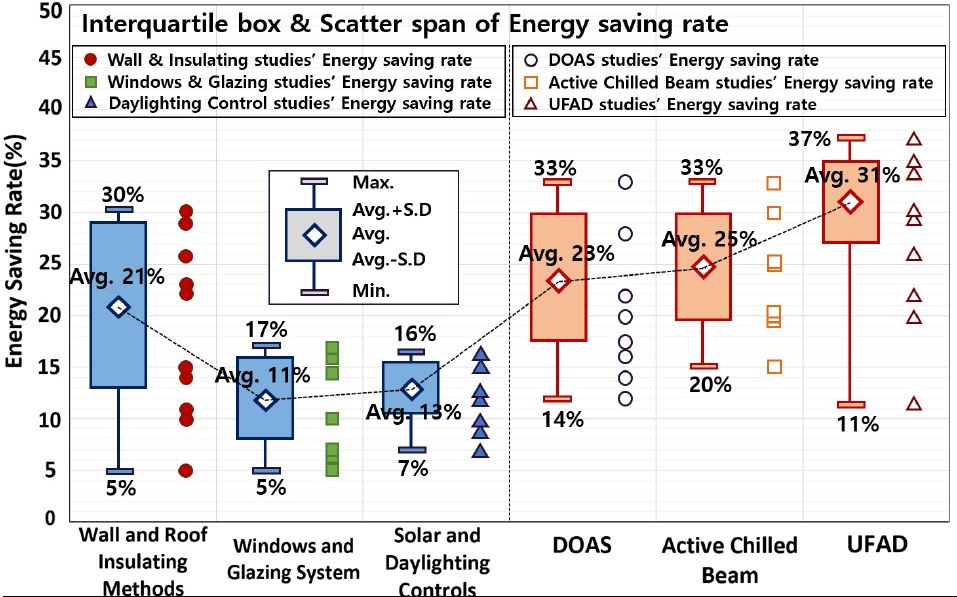
Interquartile box & Scatter span of Energy saving rate(Avg.:Average, S.D:Standard deviation, Max.:Maximum, Min.:Minimum)
즉, 건축 부문에서 에너지 절감률이 21%로 가장 컸던 Wall and Roof Insulating Method의 에너지 절감률 표준 편차(S.D)는 ±8%, 최대‧최솟값(Max., Min.)은 각각 5%, 30%의 분포를 보여 평균과의 편차가 가장 컸다. Window and Glazing System에서는 평균(Avg.) 11%, 표준편차(S.D) ±4%, 최대‧최솟값(Max.,Min.)은 각각 5%, 17%의 절감률 분포를 보였다. 평균 13%의 에너지 절감률로 분석된 Solar and Daylighting Control은 표준편차(S.D) ±2%, 최대‧최솟값(Max., Min.)은 각각 7%, 16%의 분포를 보여 평균과의 편차가 제일 적었다. 설비 부문에서 DOAS와 Active Chilled Beam 연구들에서의 평균(Avg.)에너지 절감률은 각각 23%, 25%로 비슷했으며 표준편차(S.D) 또한 ±6%, ±5%의 분포를 보여 평균과의 편차 또한 비슷한 것으로 분석되었다. UFAD의 에너지 절감률은 평균(Avg.) 31%, 표준편차(S.D) ±3.5%, 최대‧최솟값(Max.,Min.)은 각각 11%, 37%의 분포를 보였다.
4. 기술별 에너지 절감 전략 분석
Table 3에서는 기술별로 총 에너지 절감률 뿐 만 아니라 냉방‧난방‧팬 에너지 절감률을 세부적으로 분류하고, 선행 연구에서 나타난 기술별 에너지 절감 원리 및 전략을 기술하였다.
5. 결론
본 연구에서는 High-Performance Building의 구현을 위해 최근 주목을 받고, 또한 실제 건축물에 적용되고 있는 건축 부문(Passive Control)과 설비 부문(Active Control)의 신기술을 선정하고 이에 따른 선행연구들을 검토하였다. 각 신기술 적용 시 에너지 절감 효과 및 절감 전략을 평가하였으며 결론은 다음과 같다.
(1) 건축 부문(Passive Control)의 Wall and Roof Insulating Method, Window and Glazing System, Solar and Daylighting Control의 기술 적용 시 에너지 절감률은 각각 21%,11%, 13%로 평가되었고 이들의 평균값은 약 15%이다.
(2) 설비 부문(Active Control)의 DOAS, Active Chilled Beam System, UFAD의 기술 적용 시 각각 23%, 25%, 31%의 에너지 절감률을 나타냈으며 이들의 평균값은 약 26%이다.
(3) 건축 부문(Passive Control)에서 평균 21% 에너지 절감률로 평가된 Wall and Roof Insulating Method는 최소 5%부터 최대 30%까지의 에너지 절감률 분포를 보이는 것으로 평가되었다. 세부적으로 난방에너지는 약 18%의 절감효과를 나타내며, 냉방 에너지 절감효과는 약 3%이다. 이는 단열효과로 겨울철 열손실을 줄이고 외피를 통한 손실을 절감시키는 것으로 판단되며, 여름철 동안에는 열의 침입을 막아주기 때문이다.
(4) 평균 11% 에너지 절감률로 평가된 Window and Glazing System은 최소 5%부터 최대 17%의 에너지 절감률 분포를 보인다. 외부 기후에 따른 적합한 성능(U-Value, SHGC, VLT)의 창호는 난방에너지에서 약 5%의 절감효과가 있으며, 냉방에너지 절감효과는 약 23%이다. 여름철 태양열 차단으로 실내 온도 상승을 억제하여 냉방에너지 절감시키고, 겨울철 야간 실내에서 손실되는 열량을 감소시켜 난방에너지를 절감시킨다.
(5) 평균 13% 에너지 절감률로 분석된 Solar and Daylighting Control은 최소 7%에서 최대 16%의 에너지 절감률 분포를 보이는 것으로 평가되었다. 이는 Dimming 제어 등 주광을 적절히 활용하여 인공조명을 자동적으로 점등을 제어하여 조명에너지가 절감되는 것으로 판단된다.
(6) 설비 부문(Active Control)에서 평균 23% 에너지 절감률로 평가된 DOAS는 최소 14%부터 최대 33%까지의 에너지 절감률 분포를 보인다. DOAS 적용 시 난방에너지 절감효과는 약 8~12%, 냉방에너지는 약 15~20%, 팬 에너지의 절감효과는 약 20%이다. 이는 DOAS 유닛안의 현열‧전열 교환기 사용으로 냉각/제습부하를 줄여주며, 잠열부하를 제거하기 위한 필요 환기량 만큼 외기를 실내로 공급하여 소량의 외기를 도입하기 때문이다.
(7) 평균 25% 에너지 절감률로 분석된 Active Chilled Beam은 최소 15%부터 최대 33%까지의 에너지 절감률 분포를 보인다. 난방에너지 절감효과는 약 8~12%, 냉방에너지는 약 15~20%, 팬에너지의 절감효과는 약 20~30%이다. 도입 외기의 3~4배 가량이 실내 공기로 유인되어 냉각되기 때문에 공조기 측에서는 환기에 필요한 최소 외기 풍량으로도 냉방이 가능하며, 줄어든 풍량 만큼 코일에서 처리해야 하는 현열부하도 함께 감소한다.
(8) 평균 31% 에너지 절감률로 분석된 UFAD는 최소 11%부터 최대 37%까지의 에너지 절감률 분포를 보인다. 난방에너지 절감효과는 약 30~35%, 냉방에너지는 약 30~35%, 팬 에너지의 절감효과는 약 30%이다. 높은 급기온도로 공조되기 때문에 열원 사용 비율이 적고, 거주역으로 오기 전에 조명 발열이 제거되어 에너지가 절감된다. 또한 거주역만 공조하기 때문에 상대적으로 적은 풍량으로 공조 가능하며 낮은 정압, 느린 기류속도로 공조되어 공조기의 팬 용량 또한 절감된다.
(9) Passive 요소 기술 적용 시의 에너지 절감률 보다는 주요 Air–side Active 요소 기술 적용 시 절감률이 약 11%정도 높았다. 하지만 에너지 절약적 High-Performance Building의 구현을 위해서는 각 기술의 요소별 절감 전략이 반드시 고려되어야 하며, 무엇보다도 건축물 특성과 용도에 적합한 건축적 요소 기술과 설비 시스템의 유기적 조합은 매우 중요하다. 이를 위해 향후 High-Performance Building 관련 신기술의 연구 및 발전은 꾸준히 지속되어야 할 것이다.
Acknowledgments
This research was supported by a grant(15AUDP-B079104-02) from Architecture & Urban Development Research Program funded by Ministry of Land, Infrastructure and Transport of Korean government.
References
-
김철호, 양자강, 이승언, 유기형, 김강수, “High-Performance Buildings 구현을 위한 신기술 개요 및 에너지 절감 효과 분석, 대한설비공학회 학술발표대회 논문집, (2015, Jun).
Kim, Chul-Ho, Yang, Ja-Kang, Yu, Ki-Hyung, Lee, Seung-Eon, Kim, Kang-Soo, Analysis of New Technologies for Energy Conservation in High-Performance Buildings, SAREK 2015 Summer Annual Conference, The Society of Air-Conditioning and Refrigerating Engineers of Korea, (2015, Jun). -
박성태, 김강수, “건축물 용도별 분류에 따른 친환경 건축 발전 경향 연구”, 한국생태환경건축학회, 9(2), (2009, Apr).
Park, Seoung- Tae, Kim, Kang-Soo, An Analysis of the Green Building Development Trends in Accordance with Usage of Building in Certified Cases of LEED, Korea Institute of Ecological Architecture and Environment, (2009, Apr). -
Edwin Rodriguez-Ubinas, Claudio Montero, Passive design strategies and performance of Net Energy Plus Houses, Energy and Buildings, (2014).
[https://doi.org/10.1016/j.enbuild.2014.03.074]

- Piljae Im, Jeff S. Haberl, A survey of High-performance schools, Texas A&M University System Collage Station, (2006).
-
Hashem Akbari, Ronnen Levinson, Leo Rainer, Monitoring the energy-use effects of cool roofs on California commercial buildings, Energy and Buildings, (2005), (37).
[https://doi.org/10.1016/j.enbuild.2004.11.013]

-
Meral Ozel, Determination of optimum insulation thickness based on cooling transmission load for building walls in a hot climate, Energy Conversion and Management, (2013), (66).
[https://doi.org/10.1016/j.enconman.2012.10.002]

-
Wilhelm Alexander Friess, Kambiz Rakhshan, Tamer A. Hendawi, Sahand Tajerzadeh, Wall insulation measures for residential villas in Dubai: A case study in energy efficiency, Energy and Buildings, (2012), (44).
[https://doi.org/10.1016/j.enbuild.2011.10.005]

-
Tengfang Xu, Jayant Sathaye, Hashem Akbari, Vishal Garg, Surekha Tetali, Quantifying the direct benefits of cool roofs in an urban setting: Reduced cooling energy use and lowered greenhouse gas emissions, Building and Environment, (2012), (28).
[https://doi.org/10.1016/j.buildenv.2011.08.011]

-
Zhaosong Fang, Nan Li, Baizhan Li, Guozhi Luo, Yanqi Huang, The effect of building envelope insulation on cooling energy consumption in summer, Energy and Buildings, (2014), (77).
[https://doi.org/10.1016/j.enbuild.2014.03.030]

-
Dionysios I. Kolaitis, Emmanouil Malliotakis, Dimos A. Kontogeorgos, Ioannis Mandilaras, Dimitrios I. Katsourinis, Maria A. Founti, Comparative assessment of internal and external thermal insulation systems for energy efficient retrofitting of residential buildings, Energy and Buildings, (2013), (64).
[https://doi.org/10.1016/j.enbuild.2013.04.004]

-
W.J. Hee, M.A. Alghoul, B. Bakhtyar, OmKalthum Elayeb, M.A. Shameri, M.S. Alrubaih, K. Sopian, The role of window glazing on daylighting and energy saving in buildings, Renewable and Sustainable Energy Reviews, (2015), (42).
[https://doi.org/10.1016/j.rser.2014.09.020]

- Milorad Bojic, Francis Yik, Application of advanced glazing to high-rise residential buildings in Hong Kong, Building and Environment, (2007), (42).
-
Yu Huang, Jian-lei Niu, Tse-ming Chung, Comprehensive analysis on thermal and daylighting performance of glazing and shading designs on office building envelope in cooling-dominant climates, Applied Energy, (2014), (134).
[https://doi.org/10.1016/j.apenergy.2014.07.100]

-
K.I. Jensen, J.M. Schultz, F.H. Kristiansen, Development of windows based on highly insulating aerogel glazings, Journal of Non-Crystalline Solids, (2004), (350).
[https://doi.org/10.1016/j.jnoncrysol.2004.06.047]

-
M.C. Singh, S.N. Garg, Energy rating of different glazings for Indian climates, Energy, (2014), (134).
[https://doi.org/10.1016/j.energy.2009.08.013]

-
Samar Jaber, Salman Ajib, Thermal and economic windows design for different climate zones, Energy and Buildings, (2011), (43).
[https://doi.org/10.1016/j.enbuild.2011.08.019]

- Yuanyi Chen, Junjie Liu, Jingjing Pei, Xiaodong Cao, Qingyan Chen, Yi Jiang, Experimental and simulation study on the performance of daylighting in an industrial building and its energy saving potential, Energy and Buildings, (2014), (73).
-
S. Ozenc, M. Uzunoglu, O. Gluer, Experimental evaluation of the impacts of considering inherent response characteristics for lighting technologies in building energy modeling, Energy and Buildings, (2014), (77).
[https://doi.org/10.1016/j.enbuild.2014.03.062]

- Danny H.W. Li, Angela C.K. Cheung, Stanley K.H. Chow, Eric W.M. Lee, Study of daylighting data and lighting energy savings for atrium corridors with lighting dimming controls, Energy and Buildings, (2014), (72).
-
B. Roisin, M. Bodart, A. Deneyer, P. D’Herdt, Lighting energy savings in offices using different control systems and their real consumption, Energy and Buildings, (2008), (40).
[https://doi.org/10.1016/j.enbuild.2007.04.006]

- B. Roisin, M. Bodart, A. Deneyer, P. D’Herdt, An analysis of energyefficient light fittings and lighting controls, Applied Energy, (2010), (87).
-
Cheng Tian, Tingyao Chen, Hongxing Yang, Tse-ming Chung, A generalized window energy rating system for typical office buildings, Solar Energy, (2010), (84).
[https://doi.org/10.1016/j.solener.2010.03.030]

-
Fabrizio Ascione, Nicola Bianco, Rosa Francesca De Masi, Giuseppe Peter Vanoli, Rehabilitation of the building envelope of hospitals: Achievable energy savings and microclimatic control on varying the HVAC systems in Mediterranean climates, Energy and Buildings, (2013), (60).
[https://doi.org/10.1016/j.enbuild.2013.01.021]

- TIAX LLC, Rooftop Unitary Air Conditioner with Integral Dedicated Outdoor Air System, National Renewable Energy Laboratory, U.S. Department of Energy, (2006).
- Kurt W. Roth, Detlef Westphalen, John Dieckmann, Sephir D. Hamilton, William Goetzler, Energy Consumption Characteristics of Commercial Building HVAC Systems Volume III: Energy Savings Potential, DOE Report-DOAS, (2002).
- John C. Fischer, Charlene W. Bayer, Report Card on Humidity Control, ASHRAE Journal, (2003).
-
Weiwei Liu, Zhiwei Lian, Reinhard Radermacher, Ye Yao, Energy consumption analysis on a dedicated outdoor air system with rotary desiccant wheel, Energy, (2007), (32).
[https://doi.org/10.1016/j.energy.2006.11.012]

- Steven J. Emmerich, Tim McDowell, Initial Evaluation of Displacement Ventilation and Dedicated Outdoor Air Systems in Commercial Buildings, National Institute of Standards and Technology, NISTIR 7244, (2005).
- Kurt W. Roth, Detlef Westphalen, John Dieckmann, Sephir D. Hamilton, William Goetzler, Energy Consumption Characteristics of Commercial Building HVAC Systems Volume III: Energy Savings Potential, DOE Report-ACB, (2002).
- Kurt Roth, John Dieckmann, Robert Zogg, James Brodrick, Chilled Beam Cooling, ASHRAE Journal, (2007).
- H. Sachs, W. Lin, A. Lowenberger, Emerging Energy-Saving HVAC Technologies and Practices for the Buildings Sector, American Council for an Energy-Efficient Economy, (2009).
- Jeff Stein, Steven T. Taylor, AV Reheat Versus Active Chilled Beams & DOAS, ASHRAE Journal, (2013).
- Nick Searle, Chilled Beam and Radiant Cooling Basics, US Dept. of Energy Report (2001).
- Guruprakash Sastry, First Radiant Cooled Commercial Building in INDIA–Critical Analysis of Energy, Comfort and Cost, Green Initiatives Infosys Limited, (2012).
- Ghassem Heidarinejad, Mohammad Hassan Fathollahzadeh, Hadi Pasdarshahri, Effects of return air vent height on energy consumption, thermal comfort conditions and indoor air quality in an underfloor air distribution system, Energy and Buildings, (2015), (97).
- Linden, PF, Yu, Jong Keun, Webster, Tom, Bauman, Fred, Lee, Kwang Ho, Schiavon, Stefano, Daly, Allan, Simulation of energy performance of underfloor air distribution (UFAD) systems, Department of Mechanical and Aerospace Engineering University of California, (2009).
-
Ali Alajmi, Wid El-Amer, Saving energy by using underfloor air distribution (UFAD) system in commercial buildings, Energy Conversion and Management, (2010), (51).
[https://doi.org/10.1016/j.enconman.2009.12.040]

- Ali F. Alajmi, Hosny Z. Abou-Ziyan, Wid El-Amer, Energy analysis of under-floor airdistribution (UFAD) system: an office building case study, Energy Conversion and Management, (2013), (73).
- Vivian Loftness, Rohini Brahme, Michelle Mondazzi, Energy Savings Potential of Flexible and Adaptive HVAC Distribution Systems for Office Buildings Final Report, , Center for Building Performance and Diagnostics, Carnegie Mellon/Oak Ridge National Laboratory, (2002).
-
Son H. Ho, Luis Rosario, Muhammad M. Rahman, Comparison of underfloor and overhead air distribution systems in an office environment, Building and Environment, (2011).
[https://doi.org/10.1016/j.buildenv.2011.01.008]

- NIBS(National Institute of Building Sciences), The Energy Policy Act of 2005 (Public Law 109-058) Section 914, Building Standards.
